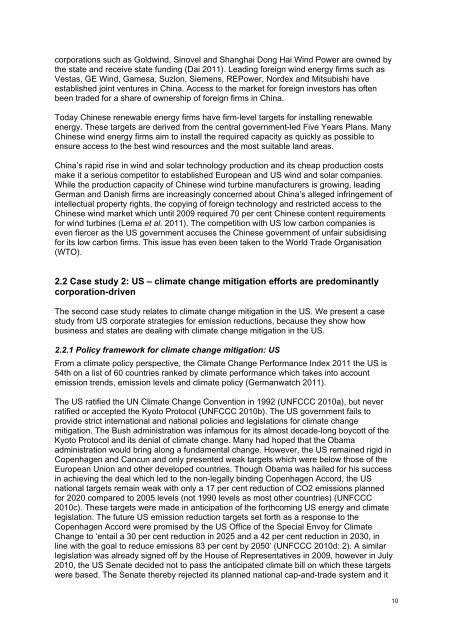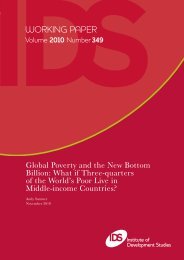IDS WORKING PAPER - Institute of Development Studies
IDS WORKING PAPER - Institute of Development Studies
IDS WORKING PAPER - Institute of Development Studies
You also want an ePaper? Increase the reach of your titles
YUMPU automatically turns print PDFs into web optimized ePapers that Google loves.
corporations such as Goldwind, Sinovel and Shanghai Dong Hai Wind Power are owned by<br />
the state and receive state funding (Dai 2011). Leading foreign wind energy firms such as<br />
Vestas, GE Wind, Gamesa, Suzlon, Siemens, REPower, Nordex and Mitsubishi have<br />
established joint ventures in China. Access to the market for foreign investors has <strong>of</strong>ten<br />
been traded for a share <strong>of</strong> ownership <strong>of</strong> foreign firms in China.<br />
Today Chinese renewable energy firms have firm-level targets for installing renewable<br />
energy. These targets are derived from the central government-led Five Years Plans. Many<br />
Chinese wind energy firms aim to install the required capacity as quickly as possible to<br />
ensure access to the best wind resources and the most suitable land areas.<br />
China’s rapid rise in wind and solar technology production and its cheap production costs<br />
make it a serious competitor to established European and US wind and solar companies.<br />
While the production capacity <strong>of</strong> Chinese wind turbine manufacturers is growing, leading<br />
German and Danish firms are increasingly concerned about China’s alleged infringement <strong>of</strong><br />
intellectual property rights, the copying <strong>of</strong> foreign technology and restricted access to the<br />
Chinese wind market which until 2009 required 70 per cent Chinese content requirements<br />
for wind turbines (Lema et al. 2011). The competition with US low carbon companies is<br />
even fiercer as the US government accuses the Chinese government <strong>of</strong> unfair subsidising<br />
for its low carbon firms. This issue has even been taken to the World Trade Organisation<br />
(WTO).<br />
2.2 Case study 2: US – climate change mitigation efforts are predominantly<br />
corporation-driven<br />
The second case study relates to climate change mitigation in the US. We present a case<br />
study from US corporate strategies for emission reductions, because they show how<br />
business and states are dealing with climate change mitigation in the US.<br />
2.2.1 Policy framework for climate change mitigation: US<br />
From a climate policy perspective, the Climate Change Performance Index 2011 the US is<br />
54th on a list <strong>of</strong> 60 countries ranked by climate performance which takes into account<br />
emission trends, emission levels and climate policy (Germanwatch 2011).<br />
The US ratified the UN Climate Change Convention in 1992 (UNFCCC 2010a), but never<br />
ratified or accepted the Kyoto Protocol (UNFCCC 2010b). The US government fails to<br />
provide strict international and national policies and legislations for climate change<br />
mitigation. The Bush administration was infamous for its almost decade-long boycott <strong>of</strong> the<br />
Kyoto Protocol and its denial <strong>of</strong> climate change. Many had hoped that the Obama<br />
administration would bring along a fundamental change. However, the US remained rigid in<br />
Copenhagen and Cancun and only presented weak targets which were below those <strong>of</strong> the<br />
European Union and other developed countries. Though Obama was hailed for his success<br />
in achieving the deal which led to the non-legally binding Copenhagen Accord, the US<br />
national targets remain weak with only a 17 per cent reduction <strong>of</strong> CO2 emissions planned<br />
for 2020 compared to 2005 levels (not 1990 levels as most other countries) (UNFCCC<br />
2010c). These targets were made in anticipation <strong>of</strong> the forthcoming US energy and climate<br />
legislation. The future US emission reduction targets set forth as a response to the<br />
Copenhagen Accord were promised by the US Office <strong>of</strong> the Special Envoy for Climate<br />
Change to ‘entail a 30 per cent reduction in 2025 and a 42 per cent reduction in 2030, in<br />
line with the goal to reduce emissions 83 per cent by 2050’ (UNFCCC 2010d: 2). A similar<br />
legislation was already signed <strong>of</strong>f by the House <strong>of</strong> Representatives in 2009, however in July<br />
2010, the US Senate decided not to pass the anticipated climate bill on which these targets<br />
were based. The Senate thereby rejected its planned national cap-and-trade system and it<br />
10

















